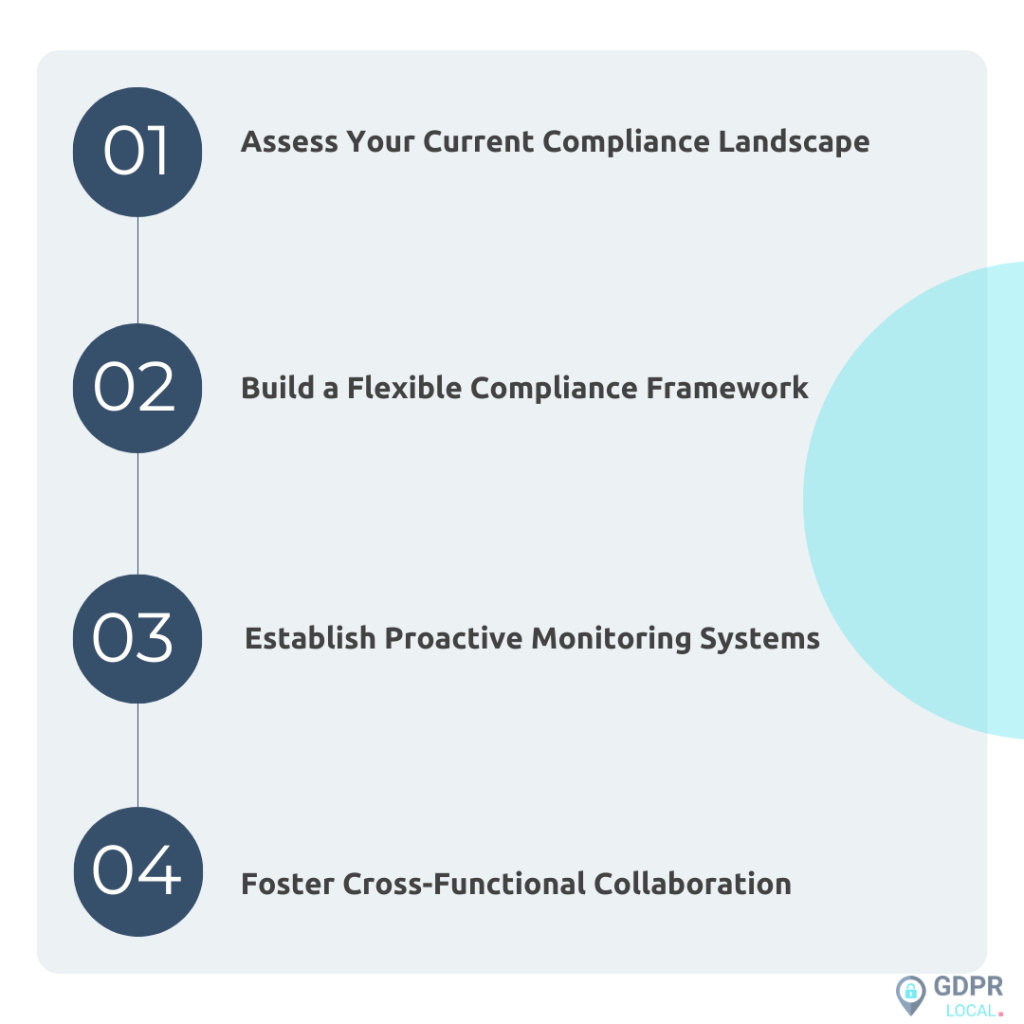
How to Develop a Long-Term Compliance Strategy for Changing Frameworks
Regulatory requirements change faster than ever, and businesses just need a strong compliance strategy to survive. Organizations struggle to balance multiple regulatory demands with their daily operations. Our experience shows that successful companies focus on building complete, adaptable compliance frameworks that handle regulatory changes well. With this blog you will learn how to evaluate your current position and implement expandable solutions. You’ll also learn to set up monitoring systems that stay ahead of regulatory changes.
Assess Your Current Compliance Landscape
Our compliance experience starts with getting a full picture of our current compliance status. Recent data shows risk and compliance professionals spend 56% of their time identifying and assessing risks, and 52% focus on monitoring compliance. These numbers highlight why we need to understand our position before implementing new strategies.
Identify applicable regulations
A complete legal requirements register serves as the foundation of regulatory compliance. This significant document helps track and manage all relevant regulations that affect our operations. The business type and location determine which regulatory frameworks need attention. These frameworks include health and safety regulations, data protection laws like GDPR, employment laws, and environmental regulations. The organization’s indexed list of legal requirements should be maintained properly. This ensures that all safety-critical tasks and their associated hazards align with minimum acceptable legal and industry standards.
Review existing compliance processes
Our organization needs to review current compliance processes that focus on three key areas:
• Document existing policies and control mechanisms
• Review compliance records to identify patterns and trends
• Compare performance against industry standards
Compliance programs must adapt to address specific organizational needs and challenges. Each key process, system, and recurring transaction requires thorough assessment to identify potential compliance risk points.
Determine compliance gaps and risks
A comprehensive gap analysis identifies differences between current compliance practices and desired standards. We systematically compare existing policies with regulatory requirements to spot areas that need improvement.
Compliance experts suggest this assessment in three key situations:
1. Setting up compliance systems for the first time
2. Updating regulatory requirements
3. Conducting internal audits
Our team should use a risk matrix to categorize identified gaps as critical, high, medium, or low based on how they affect the organization. This priority system helps allocate resources efficiently to tackle the most urgent compliance issues. Business changes like acquisitions, market expansion, corporate restructuring, or new customer relationships can create compliance risks that need constant monitoring.
A systematic approach to compliance assessment builds a strong foundation for our long-term compliance strategy. This proactive position helps avoid legal penalties and sanctions while our organization’s integrity stays intact as regulations continue to evolve.
Build a Flexible Compliance Framework
A resilient compliance framework needs careful thought about current and future regulatory just needs. We have seen that a flexible compliance framework serves as a foundation that ensures regulatory adherence and propels development of the business.
Develop adaptable policies and procedures
Policies and procedures are the foundations of any compliance framework. Research shows that effective compliance risk management is a collaborative process that utilizes various control functions within the organization.
These key elements help create adaptable policies:
• Clear documentation and accessibility
• Regular review and update cycles
• Integration with business operations
• Cross-functional collaboration opportunities
Our research reveals that compliance teams must balance two different mindsets – being a ‘trusted advisor’ and an ‘independent watchdog’. This balance plays a significant role in developing policies that remain both practical and effective.
Implement expandable compliance technology
Modern regulatory environments demand technological solutions. Studies show that compliance dashboards have become a popular tool for the ‘second-line of defense’.
Our technology solution implementation focuses on these key areas:
1. Automation of routine compliance tasks
2. Up-to-the-minute monitoring capabilities
3. Data analytics for risk assessment
4. Integrated reporting systems
5. Strong infrastructure
Technology solutions eliminate wasteful duplication and enhance information sharing. The right tools ensure that compliance metrics are more robust. These tools support an inbuilt compliance culture through accurate and reliable data.
Create a compliance-focused culture
A strong compliance culture forms the foundation of lasting success. Organizations that integrate compliance risk management effectively provide early input into product design and approval processes.
Compliance extends beyond the compliance function and should blend into daily business operations to work. Our approach includes:
• Leadership Engagement: Leaders must set and consistently enforce high ethical standards
• Continuous Education: Complete training programs customized for various employee roles
• Open Communication: Clear reporting channels that promote open dialog
• Regular Assessment: Consistent monitoring and evaluation of compliance initiatives
Organizations that encourage compliance as a core value protect their reputation, reduce risks, and build stakeholder trust. Any organization can adapt our framework based on its size, scope, and complexity.
Establish Proactive Monitoring Systems
Proactive monitoring is the life-blood of a working compliance strategy in today’s faster evolving digital world. Organizations struggle with the growing stream of regulatory information. Studies show that rule updates have increased by 500% in the last decade.
Set up regulatory change tracking
Keeping up with regulatory changes demands significant resources and carries inherent risks. Organizations that rely on manual tracking through email exchanges and website reviews face increased chances of human error.
Automated regulatory tracking systems offer a better solution that can:
• Monitor multiple regulatory sources simultaneously
• Generate up-to-the-minute alerts for relevant changes
• Streamline information collection and distribution
• Map regulations to existing policies and controls
• Enable push-button reporting capabilities
Organizations that implement automated tracking solutions achieve 40% full-time equivalent (FTE) savings through automation. This allows compliance teams to concentrate on strategic initiatives instead of manual monitoring tasks.
Conduct regular compliance audits
Compliance audits evaluate how well we follow regulatory requirements. Independent third-party auditors assess our processes and give explanations about what we can improve.
A successful audit preparation needs:
1. Documentation review and organization
2. Internal control evaluation
3. Evidence collection and presentation
4. Process assessment and validation
5. Implementation of corrective measures
Our data confirms that compliance audits build trust with external organizations and customers because they show proper controls exist. We suggest running internal audits before external assessments. This helps us spot and fix potential gaps early.
Utilize data analytics to learn more
Data analytics has brought major changes to compliance monitoring. Modern compliance tools can help financial institutions better manage regulatory change by collecting regulatory content in one place and surfacing changes specific to their organization.
Advanced analytics enables our clients to:
• Spot patterns and connections in compliance data
• Spot potential risks early
• Track compliance status immediately
• Create detailed compliance reports
Our work proves that data analytics is instrumental in helping organizations figure out large amounts of accumulated data, revealing trends, patterns, and correlations that might otherwise go unnoticed. We have learned that real-time monitoring has revolutionized compliance management by providing constant, up-to-date views of compliance status. Traditional periodic audits cannot match this capability.
Proactive monitoring systems help organizations move from reactive to proactive compliance management. This method reduces risk and transforms compliance teams from being inhibitors to enablers, elevating them to a place of strategic guidance rather than reactive prevention.
Foster Cross-Functional Collaboration
Cross-functional collaboration serves as the life-blood of our modern compliance strategy. Breaking down departmental silos substantially improves program effectiveness and builds a more resilient compliance framework. Organizations with siloed compliance requirements in scattered departments often struggle with managing procedures effectively.
Form a compliance steering committee
A dedicated compliance committee should oversee your organization’s governance, risk, and compliance (GRC) strategy. Research shows that the most effective committees include team members from every part of the enterprise. This approach prevents risks that emerge when departments operate in isolation without proper communication.
The compliance steering committee’s core responsibilities include:
• Evaluates and concludes investigation cases
• Reviews and updates internal policies and procedures
• Tracks and responds to regulatory changes
• Provides guidance on compliance-related decisions
• Ensures consistent standards between departments
Integrate compliance into business processes
Companies achieve the best results when they treat compliance as a partner rather than an individual entity. Strong relationships with shared goals and business outcomes help compliance blend into the organization’s fabric. This approach creates a “fit-for-purpose” state where companies tailor their compliance processes to meet specific needs while following regulatory requirements.
The successful integration focuses on three key areas:
1. Process Optimization
• Optimize current workflows
• Make documentation procedures standard
• Use consistent models and tools
2. Communication Channels
• Set up clear reporting lines
• Build effective feedback systems
• Keep information flow transparent
3. Risk Management
• Create proactive risk assessment methods
• Set up ongoing monitoring systems
• Design response plans for new risks
Provide ongoing compliance training
Our experience shows that a compliance-specific training strategy is vital to succeed in the long run. Compliance training is pivotal to prepare employees with the knowledge and skills they need to understand and follow regulatory standards.
We have created a detailed training approach that has:
1. Customized Learning Paths
• Compliance requirements based on roles
• Regulations specific to industry
• Procedures for each department
2. Modern Training Methods
• Microlearning sessions that support continuous education
• Game elements that boost participation
• In-app reminders that guide at the right time
Our cross-functional collaboration implementation has shown remarkable improvements in how well compliance works. Cross-functional teams spread knowledge and bring different viewpoints that help find innovative solutions to existing problems. This team-based approach will give a strong foundation where compliance becomes part of your organization’s culture instead of standing alone.
Regular feedback sessions and performance metrics help assess how well teams work together. This helps spot areas we can improve and keeps our cross-functional approach in step with changing regulatory requirements.

Conclusion
Effective compliance strategy needs a balanced mix of getting the full picture, adaptable frameworks, and active monitoring systems. Companies that excel at regulatory compliance know the value of regular evaluations, adaptable policies, and technology solutions. Strong compliance programs succeed through teamwork. Teams identify risks, implement controls and maintain regulatory adherence in business units of all sizes.
Regular training, open communication, and evidence-based analysis help organizations remain competitive with regulatory changes. This encourages a culture where compliance becomes natural rather than an afterthought.
GDPRLocal stands at your disposal. Your compliance is our priority. Contact us at [email protected].